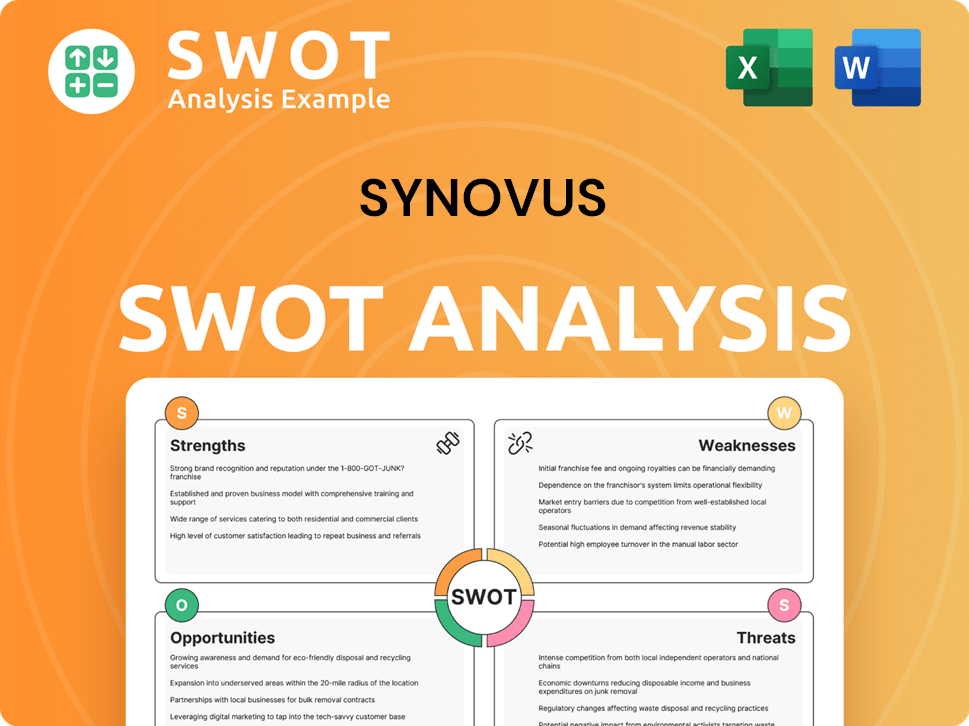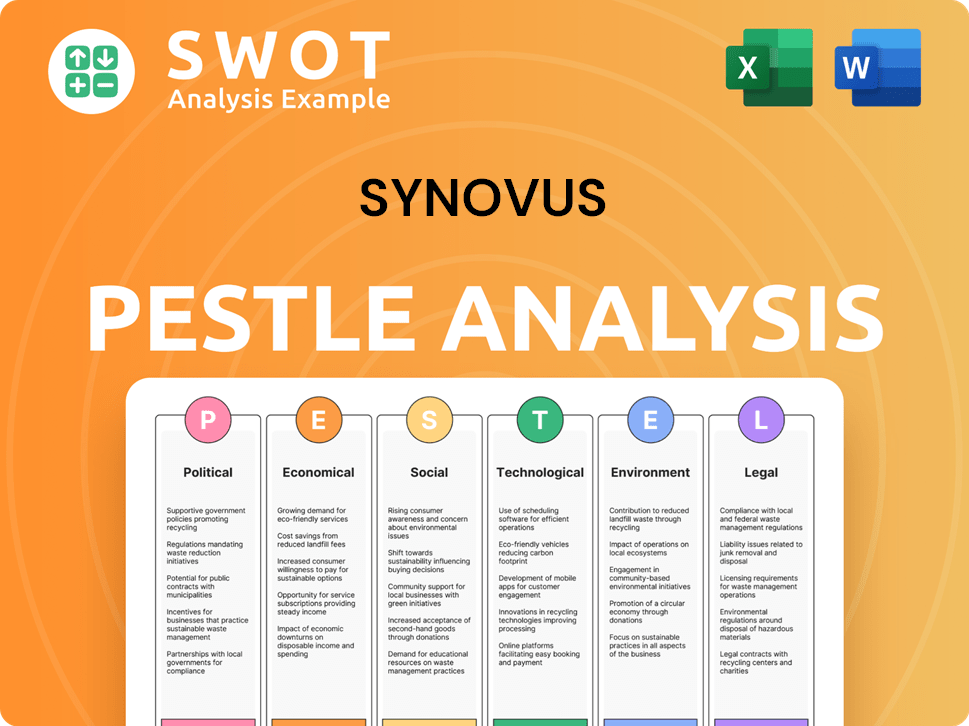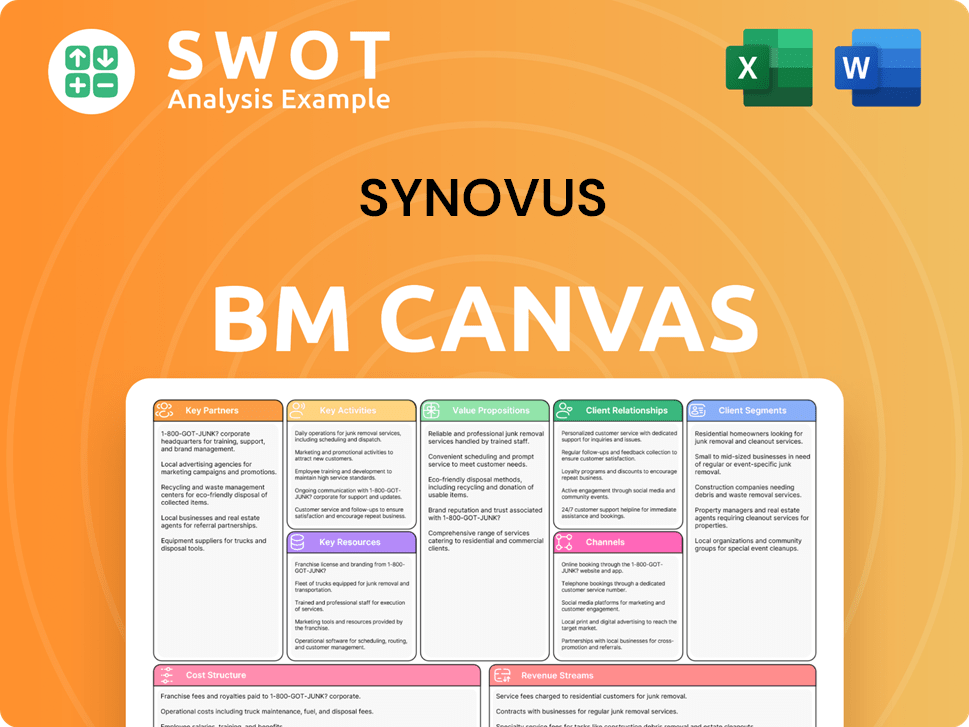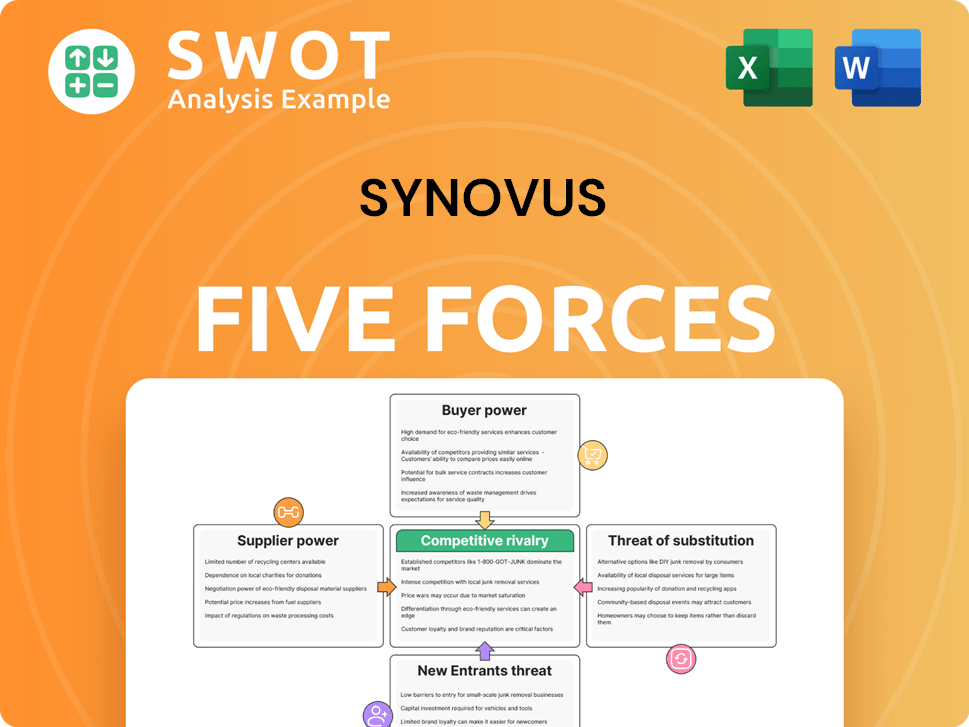Synovus Bundle
How Does Synovus Navigate the Banking Sector's Competitive Waters?
The financial services industry is a battlefield, constantly reshaped by technology and shifting consumer demands. Synovus Financial Corp., a prominent regional player, faces this challenge head-on, offering a range of services from commercial and retail banking to investments and mortgages. Understanding the Synovus SWOT Analysis is crucial to grasping its position.

This exploration of the Synovus competitive landscape will dissect its position within the Synovus industry analysis, pinpointing key Synovus competitors and evaluating its strategic initiatives. We'll delve into Synovus market analysis, examining its financial performance and competitive advantages to understand how Synovus maintains its market share analysis 2024 and adapts to the evolving banking sector.
Where Does Synovus’ Stand in the Current Market?
Synovus Financial Corp. maintains a strong regional market position, primarily focused on the Southeastern United States. As of the first quarter of 2024, the company held total assets of $61.7 billion, demonstrating its significant scale within the regional banking sector. This strong foundation allows it to compete effectively in its core markets.
The company's primary product lines include a comprehensive suite of commercial and retail banking services. These services encompass deposit accounts, various loan products (commercial, real estate, and consumer), and wealth management solutions. Synovus serves a diverse customer base, ranging from individuals and small businesses to larger corporations, providing a broad range of financial solutions.
Synovus's strategy of operating through community bank divisions allows it to maintain strong local ties and a competitive edge. This approach helps them to build customer loyalty and deepen relationships within their geographic footprint. For a deeper understanding of their customer focus, consider exploring the Target Market of Synovus.
Synovus consistently ranks among the top banks in the Southeast, leveraging its community-oriented approach to build customer loyalty. While specific market share figures are not always available, the company's strong presence in key states like Georgia, Alabama, and Florida indicates a significant competitive position. This regional concentration is a key aspect of the Synovus competitive landscape.
Synovus's financial health, as indicated by its Q1 2024 earnings, shows a net income of $128 million, reflecting its ability to generate profits amidst economic fluctuations. The company's focus on credit quality, with net charge-offs at 0.36% of average loans in Q1 2024, further solidifies its stable market position. These figures highlight Synovus's financial performance.
Synovus differentiates itself through its community banking model, fostering strong local relationships and providing personalized service. Its digital transformation efforts enhance its service offerings and reach, adapting to changing customer preferences. This approach helps them to maintain a competitive edge in the banking sector.
Synovus focuses on digital transformation to enhance its service offerings and reach, adapting to changing customer preferences and industry trends. The company's recent strategic initiatives include investments in technology and expansion of its wealth management services to broaden its offerings and maintain a competitive advantage. These initiatives are crucial for navigating the Synovus industry analysis.
Synovus's competitive position is shaped by its regional focus, strong customer relationships, and digital transformation efforts. The company's ability to adapt to changing market conditions and maintain a solid financial performance is crucial. The competitive landscape includes a variety of Synovus competitors.
- Community banking model fostering strong local ties.
- Digital transformation to enhance service offerings.
- Focus on credit quality and financial stability.
- Strategic geographic focus in the Southeastern United States.
Synovus SWOT Analysis
- Complete SWOT Breakdown
- Fully Customizable
- Editable in Excel & Word
- Professional Formatting
- Investor-Ready Format

Who Are the Main Competitors Challenging Synovus?
The financial services industry is highly competitive, and the Synovus competitive landscape is shaped by a diverse range of rivals. Understanding Synovus's competitors is crucial for assessing its market position and strategic direction. This analysis provides insights into the key players challenging Synovus in the banking sector.
Synovus market analysis reveals a complex environment where both direct and indirect competitors vie for market share. The competitive dynamics are influenced by factors like geographic reach, service offerings, and technological innovation. This chapter explores the main rivals and the strategies Synovus employs to maintain its competitive edge.
Synovus operates in a highly competitive financial services industry, facing challenges from a diverse array of direct and indirect competitors. Its most significant direct competitors are often larger regional banks and national banks with a substantial presence in the Southeastern United States. These include institutions such as Truist Financial Corporation, Wells Fargo & Company, Bank of America Corporation, and PNC Financial Services Group. These larger banks often have broader geographic reach, more extensive branch networks, and greater financial resources, allowing them to offer a wider range of services and potentially more competitive pricing on certain products. For instance, Truist, formed from the merger of BB&T and SunTrust, presents a formidable rival with a strong regional presence and diversified offerings.
Direct competitors include large regional and national banks with a significant presence in the Southeast. These banks often have greater resources and broader service offerings.
Truist, formed from the merger of BB&T and SunTrust, is a major competitor with a strong regional presence and diversified offerings, making it a formidable rival to Synovus.
Smaller community banks also compete with Synovus, leveraging deep community ties and personalized service to attract and retain customers.
Indirect competitors include credit unions, which offer competitive rates, and fintech companies, which disrupt traditional banking with digital-first services.
Fintechs offer specialized digital-first services, such as online lending and payment processing, posing a challenge to traditional banking models.
Mergers and acquisitions shape the competitive landscape, potentially creating stronger competitors with diversified offerings and increased market share.
Beyond these large players, Synovus also competes with numerous smaller community banks within its specific operating markets. These local institutions often leverage their deep community ties and personalized service to attract and retain customers, posing a competitive challenge to Synovus's community-focused model. Indirect competitors include credit unions, which often offer competitive rates on deposits and loans due to their non-profit status, and increasingly, financial technology (fintech) companies. Fintechs are disrupting traditional banking by offering specialized digital-first services, such as online lending platforms, payment processing solutions, and investment apps, which can be more agile and customer-centric in specific niches. The competitive landscape is also shaped by mergers and acquisitions, which can lead to shifts in market share and create stronger, more diversified competitors. Synovus continuously navigates these competitive pressures by emphasizing its relationship-based banking model and investing in technology to enhance its customer experience.
Synovus faces competition based on several factors, including geographic reach, service offerings, pricing, and technological innovation. Understanding these factors is crucial for evaluating Synovus's financial performance.
- Geographic Footprint: Larger banks with extensive branch networks have a broader reach.
- Service Range: Competitors with a wider array of financial products and services.
- Pricing: Competitive interest rates on loans and deposits.
- Technology: Digital banking capabilities and customer experience.
To gain a deeper understanding of how Synovus is navigating its competitive environment, consider exploring the Growth Strategy of Synovus. This analysis provides insights into Synovus's strategic initiatives and how it aims to maintain its competitive advantage in the face of these challenges.
Synovus PESTLE Analysis
- Covers All 6 PESTLE Categories
- No Research Needed – Save Hours of Work
- Built by Experts, Trusted by Consultants
- Instant Download, Ready to Use
- 100% Editable, Fully Customizable

What Gives Synovus a Competitive Edge Over Its Rivals?
Understanding the Brief History of Synovus is crucial for analyzing its competitive advantages. Synovus distinguishes itself in the competitive financial landscape through several key strengths. Its community-centric banking model, operating through multiple local bank divisions, fosters deep customer relationships and local market expertise. This approach allows Synovus to tailor services and build strong community ties, setting it apart from larger, more centralized banks.
Synovus's robust and diversified service offerings are another significant advantage. The company provides a comprehensive suite of commercial and retail banking, investment, and mortgage services. This breadth of services caters to a wide array of financial needs for individuals and businesses, strengthening its position as a holistic financial partner. Strategic investments in technology and digital transformation further enhance its competitive edge.
Synovus's prudent risk management and strong credit quality, as evidenced by its net charge-offs of 0.36% in Q1 2024, also contribute to its stability and reputation. These advantages, rooted in its community focus, diversified offerings, and commitment to technology, have evolved to allow Synovus to compete effectively against both larger national banks and smaller local institutions. This is a crucial element in any Synovus market analysis.
Synovus's localized approach fosters deep customer relationships and local market expertise. This model allows for tailored services and strong community ties. This strategy contributes to strong brand equity and customer loyalty within its operating regions, impacting the Synovus competitive landscape.
Synovus provides a comprehensive suite of commercial and retail banking, investment, and mortgage services. This breadth of services caters to a wide array of financial needs for individuals and businesses. It strengthens its position as a holistic financial partner, which is important for Synovus competitors to consider.
Synovus has made strategic investments in technology and digital transformation. This enhances its online and mobile banking platforms to meet evolving customer expectations for convenience and accessibility. The company aims to provide competitive digital tools that complement its personal service.
Synovus demonstrates prudent risk management and strong credit quality. This is evidenced by its net charge-offs of 0.36% in Q1 2024. This fosters trust among its clientele and contributes to its overall stability and reputation within the banking sector.
Synovus leverages its community-focused banking model and diversified services to compete effectively. Its strategic investments in technology and prudent risk management further enhance its competitive position. These elements are crucial for its Synovus financial performance.
- Community-Centric Approach: Fosters strong customer relationships and local market expertise.
- Diversified Services: Offers a comprehensive suite of financial products.
- Technological Investments: Enhances digital banking platforms.
- Prudent Risk Management: Maintains strong credit quality and stability.
Synovus Business Model Canvas
- Complete 9-Block Business Model Canvas
- Effortlessly Communicate Your Business Strategy
- Investor-Ready BMC Format
- 100% Editable and Customizable
- Clear and Structured Layout

What Industry Trends Are Reshaping Synovus’s Competitive Landscape?
The financial services industry is undergoing significant transformation, presenting both challenges and opportunities for institutions like Synovus. The Synovus competitive landscape is shaped by technological advancements, regulatory changes, and evolving consumer preferences. Understanding these dynamics is crucial for assessing Synovus market analysis and future prospects.
Synovus industry analysis reveals a need for continuous adaptation to maintain a competitive edge. This involves strategic investments in digital infrastructure, compliance efforts, and innovative product offerings. Moreover, the rise of fintech companies and shifting economic conditions add further complexity to the Synovus banking sector.
Technological advancements, including AI, machine learning, and blockchain, are reshaping banking operations. Regulatory changes related to consumer protection and data privacy are impacting financial institutions. Consumers are increasingly demanding personalized, convenient, and digitally accessible services, driving the need for innovation.
Balancing the traditional community banking model with digital transformation is a key challenge. Competition from non-bank financial institutions and economic fluctuations, such as interest rate changes, pose risks. Maintaining robust cybersecurity and adapting to evolving consumer expectations are ongoing concerns.
Expanding market share in underserved areas within the Southeast presents growth potential. Leveraging data analytics for personalized product offerings and strategic partnerships with fintech companies can drive innovation. Growth opportunities exist in niche markets, such as specialized lending and enhanced wealth management services.
Investing in technology, talent, and targeted market expansion is crucial. Focusing on customer experience and building strategic partnerships can enhance competitiveness. Adapting to changing consumer demands and economic conditions is essential for long-term resilience and growth.
Synovus's ability to navigate the evolving financial landscape hinges on several factors. This includes the effectiveness of its digital transformation strategy and its capacity to manage risks associated with economic volatility. It also involves the ability to capitalize on opportunities for growth and innovation.
- Focus on digital banking and fintech partnerships to remain competitive.
- Enhance cybersecurity measures to protect customer data.
- Adapt to changing consumer preferences by offering personalized services.
- Explore strategic acquisitions to expand market share.
Synovus Porter's Five Forces Analysis
- Covers All 5 Competitive Forces in Detail
- Structured for Consultants, Students, and Founders
- 100% Editable in Microsoft Word & Excel
- Instant Digital Download – Use Immediately
- Compatible with Mac & PC – Fully Unlocked

Related Blogs
- What are Mission Vision & Core Values of Synovus Company?
- What is Growth Strategy and Future Prospects of Synovus Company?
- How Does Synovus Company Work?
- What is Sales and Marketing Strategy of Synovus Company?
- What is Brief History of Synovus Company?
- Who Owns Synovus Company?
- What is Customer Demographics and Target Market of Synovus Company?
Disclaimer
All information, articles, and product details provided on this website are for general informational and educational purposes only. We do not claim any ownership over, nor do we intend to infringe upon, any trademarks, copyrights, logos, brand names, or other intellectual property mentioned or depicted on this site. Such intellectual property remains the property of its respective owners, and any references here are made solely for identification or informational purposes, without implying any affiliation, endorsement, or partnership.
We make no representations or warranties, express or implied, regarding the accuracy, completeness, or suitability of any content or products presented. Nothing on this website should be construed as legal, tax, investment, financial, medical, or other professional advice. In addition, no part of this site—including articles or product references—constitutes a solicitation, recommendation, endorsement, advertisement, or offer to buy or sell any securities, franchises, or other financial instruments, particularly in jurisdictions where such activity would be unlawful.
All content is of a general nature and may not address the specific circumstances of any individual or entity. It is not a substitute for professional advice or services. Any actions you take based on the information provided here are strictly at your own risk. You accept full responsibility for any decisions or outcomes arising from your use of this website and agree to release us from any liability in connection with your use of, or reliance upon, the content or products found herein.